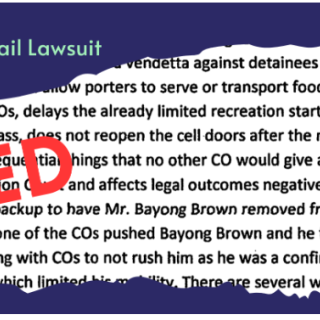Retired Army and Air Force Reserve Sergeant Adrienne Hood waited five years and five months to prove to a jury that Columbus Division of Police officers Zachary Rosen and Jason Bare used excessive force causing the death of her son, Henry Green V, during the summer of 2016.
After the first full day of deliberation on Tuesday at the federal courthouse in Columbus, the three men and five women on the jury claimed they could not reach a consensus. US District Judge Edmond A. Sargus, Jr., instructed them to return the next day and try again. Two jurors left the courtroom in tears.
The following morning the only Black juror explained to the judge that she and other jurors felt pressured by some of the jurors. She insisted that she was not going to change her vote. Sargus sent her back to the jury room to work toward a consensus one more time.
At 2pm he brought the jury back into the courtroom full of the family and supporters of Henry Green, including several mothers of other young Black men killed by police actions. Officers Rosen and Bare were not present.
Sargus asked the jury if more time would help them reach a unanimous decision. They didn't think it would. He then declared a mistrial.
Hood’s attorney, N. John Bey of Atlanta, summarized the case for the jury by claiming that Rosen fired a fatal shot into Green’s heart through his shoulder while Green was kneeling on the ground after he had dropped his gun. Once Green was no longer a threat, Bey argued that Rosen’s final shots were excessive force and a violation of Green’s constitutional rights.
Rosen and Bare’s attorney, Westley Phillips, chief of the Columbus City Attorney’s litigation division, countered by discrediting every witness from the Linden neighborhood who provided testimony. He proposed that the final shots were reasonable given the officers were involved in an active shoot out and it would have been hard for them to discern when the threat was over. The entire incident lasted between 3 and 10 seconds, according to witnesses.
The original lawsuit filed by Hood also named the City of Columbus as a defendant. That suit was dismissed by the court and Hood appealed. On appeal the claim against the city was dropped but the qualified immunity of the officers was not maintained, allowing the case to return to the lower court for trial against the officers, but only for a portion of the original claims.
When Rosen and Bare encountered Green walking home in his South Linden neighborhood, they were driving an unmarked SUV rental car with Florida plates. It did not have an installed dashcam. They were not in uniform nor wearing body-worn cameras. They were in the area to provide surveillance during the City’s “summer safety initiative.” There had been a drive-by shooting the week before on the street where Green lived.
Witnesses claimed the officers did not identify themselves nor display their badges as they claimed they did. The only video provided to the jury was from a marked police vehicle dash cam that arrived shortly after Green was shot.
This trial could not debate who shot first during the initial encounter. The appeals court held that the officers were justified in using deadly force initially against Green, who was legally carrying a gun and not a suspect in any crime.
This case debated the sequence of events during the final seconds of the encounter. Testimony from the defense’s own expert witness seemed to prove the plaintiff’s case by saying the deadly shot could not have entered Green’s shoulder during the time he was shooting at the officers if he had been positioned in the manner the officers both described during their testimony.
Green would have been kneeling on the ground as witnesses described, to be able to receive at least two of the gunshot wounds he suffered, including the shot that entered the top of his shoulder and traveled to his heart, taking his life.
The plaintiff also implied that the investigation of the case was mishandled by CPD and the coroner’s office when the initial detective report listed Green as the “suspect” and the officers as the “victims.” The initial autopsy report failed to list two bullet wounds to Green’s back and placed the shot that killed him on the wrong shoulder.
Neither officer was indicted for any crime related to this case. After this incident, Rosen was terminated when he was caught on cell phone video kicking a prone handcuffed suspect in the head. He was later reinstated.
The judge will meet with the attorneys in the case in a couple of days to determine where the case will go from here.
Sean Walton, an attorney for the plaintiff, released a statement following the trial stating that they will keep fighting for Henry Green.
Related links:
Protesters demand justice for Henry Green, end to Community Safety Initiative
Family of Henry Green, community members speak out against racist police brutality
Black Lives Matter protesters shut down Columbus City Council meeting, demand change
Columbus City Council pledges to re-evaluate Summer Safety Initiative, little else



